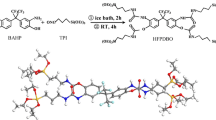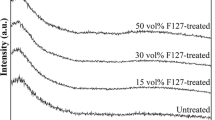Abstract
In this work, a novel bridged organosilane precursor, adamantane-bridged organosilane (ADBO), was synthesized successfully which was employed to prepare adamantane-based (ADH-based) periodic mesoporous organosilica (PMO) thin film in the presence of porogen and acid catalyst via evaporation-induced self-assembly (EISA) after spin-coating procedure. The resultant ADH-based PMO thin films were characterized by FTIR, NMR, TEM, and small-angle XRD. The ADH-based PMO thin film with weight ratio of porogen to ADBO (0.75:1) possesses low dielectric constant (1.55 ± 0.04@1 MHz), excellent Young’s modulus (6.69 ± 0.54 GPa), and ideal hydrophobic property (90.2° of water contact angle) simultaneously. These outstanding properties of ADH-based PMO film can be ascribed to lower polarity, lower density, and rigid cavity structure of adamantane, which suggests its potential application as high-performance low-κ material in next-generation microelectronics.










Similar content being viewed by others
References
Kohl PA (2011) Low-dielectric constant insulators for future integrated circuits and packages. Annu Rev Chem Biomol 2:379–401
Baklanov MR, Maex K (2006) Porous low dielectric constant materials for microelectronics. Philos Trans R Soc A 364:201–215
Shamiryan D, Abell T, Iacopi F, Maex K (2004) Low-k dielectric materials. Mater Today 7:34–39
Hatton BD, Landskron K, Hunks WJ, Bennett MR, Shukaris D, Perovic DD, Ozin GA (2006) Materials chemistry for low-k materials. Mater Today 9:22–31
Maex K, Baklanov MR, Shamiryan D, lacopi F, Brongersma SH, Yanovitskaya ZS (2003) Low dielectric constant materials for microelectronics. J Appl Phys 93:8793–8841
Wang WD, Lofgreen JE, Ozin GA (2010) Why PMO? Towards functionality and utility of periodic mesoporous organosilicas. Small 6:2634–2642
Wang WD, Grozea D, Kohli S, Perovic DD, Ozin GA (2011) Water repellent periodic mesoporous organosilicas. ACS Nano 5:1267–1275
Yang QH, Liu J, Zhang L, Li C (2009) Functionalized periodic mesoporous organosilicas for catalysis. J Mater Chem A 19:1945–1955
Lin CX, Qiao SZ, Yu CZ, Ismadji S, Lu GQ (2009) Periodic mesoporous silica and organosilica with controlled morphologies as carriers for drug release. Micro Mesopor Mat 117:213–219
Wang XQ, Lu DN, Austin R, Agarwal A, Mueller LJ, Liu Z, Wu JZ, Feng PY (2007) Protein refolding assisted by periodic mesoporous organosilicas. Langmuir 23:5735–5739
Rebbin V, Schmidt R, Fröba M (2006) Spherical particles of phenylene-bridged periodic mesoporous organosilica for high-performance liquid chromatography. Angew Chem Int Ed 45:5210–5214
Tani T, Mizoshita N, Inagaki S (2009) Luminescent periodic mesoporous organosilicas. J Mater Chem 19:4451–4456
Hunks WJ, Ozin GA (2005) Challenges and advances in the chemistry of periodic mesoporous organosilicas (PMOs). J Mater Chem 15:3716–3724
Wills AW, Michalak DJ, Ercius P, Rosenberg ER, Perciano T, Ushizima D, Runser R, Helms BA (2015) Block copolymer packing limits and interfacial reconfigurability in the assembly of periodic mesoporous organosilicas. Adv Funct Mater 25:4120–4128
Hoffmann F, Cornelius M, Morell J, Fröba M (2006) Silica-based mesoporous organic–inorganic hybrid materials. Angew Chem Int Ed 45:3216–3251
Liu HC, Su WC, Liu YL (2011) Self-assembled benzoxazine-bridged polysilsesquioxanes exhibiting ultralow-dielectric constants and yellow-light photoluminescent emission. J Mater Chem 21:7182–7187
Hatton BD, Landskron K, Whitnall W, Perovic DD, Ozin GA (2005) Spin-coated periodic mesoporous organosilica thin film-towards a new generation of low-dielectric-constant materials. Adv Funct Mater 15:823–829
Jiang T, Zhu B, Ding SJ, Fan ZY, Zhang DW (2014) High-performance ultralow dielectric constant carbon-bridged mesoporous organosilica films for advanced interconnects. J Mater Chem C 2:6502–6510
Huang YQ, Economy J (2006) New high strength low-k spin-on thin films for IC application. Macromolecules 39:1850–1853
Edelstein D (2008) Extendibility of Cu/low-k/airgap BEOL. Electrochem Soc 28:2073
Guo Y, Mylonakis A, Zhang ZT, Yang GL, Lelkes PI, Che SN, Lu QH, Wei Y (2008) Templated synthesis of electroactive periodic mesoporous organosilica bridged with oligoaniline. Chem-Eur J 14:2909–2917
Landskron K, Ozin GA (2005) Periodic mesoporous organosilicas: self-assembly from bridged cyclic silsesquioxane precursors. Angew Chem Int Ed 44:2107–2109
Gao L, Wei F, Zhou Y, Fan XX, Wang Y, Zhu JH (2009) Periodic mesoporous organosilica materials: self-assembly of carbamothioic acid-bridged organosilane precursors. Chem-Eur J 15:8310–8318
Schachtschneider A, Wessig M, Spitzbarth M, Donner A, Fischer C, Drescher M, Polarz S (2015) Directional materials-nanoporous organosilica monoliths with multiple gradients prepared using click chemistry. Angew Chem Int Ed 127:10611–10615
Seino M, Wang WD, Lofgreen JE, Puzzo DP, Manabe T, Ozin GA (2011) Low-k periodic mesoporous organosilica with air walls: POSS-PMO. J Am Chem Soc 133:18082–18085
Lu HY, Teng CL, Kung CH, Wan BZ (2011) Preparing mesoporous low-k films with high mechanical strength from noncrystalline silica particles. Ind Eng Chem Res 50:3265–3273
Goethals F, Levrau E, Pollefeyt G, Baklanov MR, Ciofi I, Vanstreels K, Detavernier C, Driessche IV, PVD Voort (2013) Sealed ultra low-k organosilica films with improved electrical, mechanical and chemical properties. J Mater Chem C1:3961–3966
Yuan H, Xu JQ, Xie LL (2011) Ultra low-dielectric-constant methylated mesoporous silica films with high hydrophobicity and stability. Mater Chem Phys 129:1195–1200
Rathore JS, Interrante LV, Dubois G (2008) Ultra low-k films derived from hyperbranched polycarbosilanes (HBPCS). Adv Funct Mater 18:4022–4028
Zhang JW, Zhang GP, Gao YJ, Sun R, Wong CP (2016) Ultra-low-κ HFPDB-based periodic mesoporous organosilica film with high mechanical strength for interlayer dielectric. J Mater Sci 51:7966–7976
Zhang GP, George TF, Assoufid L, Mansoori GA (2007) First-principles simulation of the interaction between adamantane and an atomic-force-microscope tip. Phys Rev B 75:035413
Fort RC, Schleyer PV (1964) Adamantane: consequences of the diamondoid structure. Chem Rev 64:277–300
Tong J, Zhang H, Gu J, Li L, Ma C, Zhao J, Wang C (2016) Poly (ethylene glycol)-block-poly (propylene glycol)-block-poly (ethylene glycol)-assisted synthesis of graphene/polyaniline composites as high-performance supercapacitor electrodes. J Mater Sci 51:1966–1977
Landskron K, Hatton BD, Perovic DD, Ozin GA (2003) Periodic mesoporous organosilicas containing interconnected [Si(CH2)]3 rings. Science 302:266–269
Acknowledgements
This work was financially supported by National Natural Science Foundation of China (Grant No. 21201175, 61505123, and 21601065), NSFC––Guangdong Jointed Funding (U1601202), NSFC––Shenzhen Robot Jointed Funding (U1613215), Guangdong and Shenzhen Innovative Research Team Program (No. 2011D052, KYPT20121228160843692), Key Laboratory of Guangdong Province (2014B030301014), and R&D Funds for basic Research Program of Shenzhen (Grant No. JCYJ20120615140007998, 20150401145529012, and 20150525092940976) and Shenzhen Fundamental Research Program (Grant No. JCYJ20160331191741738 and JSGG20160229194437896).
Author information
Authors and Affiliations
Corresponding authors
Ethics declarations
Conflict of interest
The authors declare that they have no conflict of interest.
Additional information
Highlights
-
Design a novel bridged organosilane precursor, introdcuing adamantane (ADH) with rigid cavity structure
-
Prepare adamantane-based (ADH-based) periodic mesoporous organosilica (PMO) through evaporation-induced self-assembly (EISA)
-
The best ADH-based PMO possesses low dielectric constant (1.55 ± 0.04@1 MHz), excellent Young’s modulus (6.69 ± 0.54 GPa), and ideal hydrophobic property (90.2° of water contact angle) simultaneously
Electronic supplementary material
Rights and permissions
About this article
Cite this article
Zhang, G., Zhang, J., Niu, F. et al. Novel adamantane-based periodic mesoporous organosilica film with ultralow dielectric constant and high mechanical strength. J Sol-Gel Sci Technol 85, 703–711 (2018). https://doi.org/10.1007/s10971-018-4582-5
Received:
Accepted:
Published:
Issue Date:
DOI: https://doi.org/10.1007/s10971-018-4582-5




